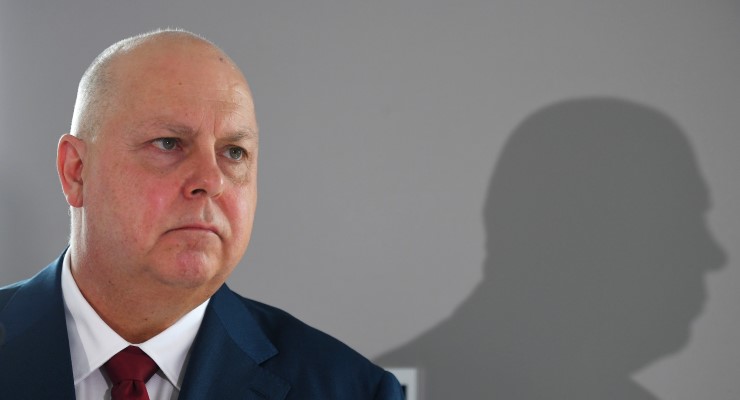
What remarkable sophistry governments engage in when it comes to discussing wages. And not just Coalition governments.
Last week’s federal budget predicted that even a fall in unemployment to levels not seen since the days before social media wouldn’t shift the dial on wages growth out of the doldrums — and casually blamed state government wage caps along the way. Nothing about the wages cap of the nation’s biggest employer, the Commonwealth public service.
At least Josh Frydenberg and his Treasury minions acknowledged a role for public sector wages policy in affecting wages growth. The Victorian government and its treasurer Tim Pallas would have us believe that wages growth floats free of any connection with what that state’s biggest employer does.
Pallas’ budget papers note that “Victorian wages growth had been subdued in recent years”, got worse during the pandemic, but “as the economy recovers and spare capacity in the labour market is gradually reduced, wages growth is expected to increase moderately over the remainder of the forecast period from the current very low rates”.
Not a word about Pallas’ own wages policy for his public service — which the budget papers elsewhere describe as a “rebalancing”.
“Employee expenses (including superannuation) are forecast to grow by 9.6% in 2021-22. The growth over the budget and forward estimates reflects the government’s response to the pandemic, increased service delivery, primarily in public health, mental health and education and an increase in the superannuation interest expense on the state’s defined benefit superannuation liability attributable to an increase in bond yields. It also includes the impact of rebalancing the government’s wages policy.”
That “rebalancing” is a cut in the Victorian public service pay rise cap to 2% from 3%, along with a cut in the guaranteed annual base increase for public servants from 2% to 1.5%, below inflation, and the same level as that of the NSW government. That’s the actual level of pay rises public servants get — as distinct from the total spend on employees in the public sector, which changes depending on how many people are employed.
The beloved-by-progressives Andrews government is thus further tightening its restrictions on wages growth which, as the state’s biggest employer, will inevitably filter through to the wider Victorian employment market.
Pallas’ wages growth forecasts are even lower than those of Frydenberg: from 2022, Victorian wages growth is forecast a quarter of a percent lower each year to 2025 than the federal budget projections.
Pallas also forecasts poor employment outcomes for Victoria: unemployment next financial year of 5.75%, followed by 5.5% in 2022-23, and two years of 5.25% — well above the nationwide forecasts of 4.5% by 2023.
Based on yesterday’s jobs data for April from the Australian Bureau of Statistics, that means unemployment will rise in coming months, because in April it fell to 5.5% in Victoria, seasonally adjusted — the same level as nationally. Unlike NSW, Queensland, Tasmania and Western Australia, employment actually rose, albeit marginally, in Victoria — a strong achievement given April marked the first month without JobKeeper.
In fact the jobs market took the end of JobKeeper pretty well: there was a net fall in employment of around 30,000 jobs, the first since September, caused by a 64,000 job fall in part-time employment, so it took a fall in the participation rate to produce a fall in the headline unemployment rate. But given the dire predictions of joblessness in the wake of the end of JobKeeper, the result was a strong one, and suggests the government got the timing of its withdrawal of JobKeeper about right.
One problem, though, was that the fall in the participation rate was heavily tilted to female employees: female participation fell 0.5% compared to male participation (-0.1%), which makes sense given it was part-time employment that was hit hardest by the end of JobKeeper.
Frydenberg was happy to take credit for the jobs numbers yesterday at a lunchtime media conference, but conveniently only held a presser on Wednesday before the weak Wage Price Index data for the March quarter was released.
Qantas won’t be helping the employment or wages growth situation in coming quarters: yesterday it announced the sacking of several hundred international cabin crew because of the delay to the reopening of Australia’s borders, and a two year pay freeze for 16,000 of its much-reduced work force.
The persistence of public sector wage caps like those of Pallas and Frydenberg continues to make life difficult for the Reserve Bank and its goal of wages growth sufficient to drive inflation up over 2% on a sustained basis, at which point it can normalise monetary policy. That still looks a long way off.









Crikey is committed to hosting lively discussions. Help us keep the conversation useful, interesting and welcoming. We aim to publish comments quickly in the interest of promoting robust conversation, but we’re a small team and we deploy filters to protect against legal risk. Occasionally your comment may be held up while we review, but we’re working as fast as we can to keep the conversation rolling.
The Crikey comment section is members-only content. Please subscribe to leave a comment.
The Crikey comment section is members-only content. Please login to leave a comment.